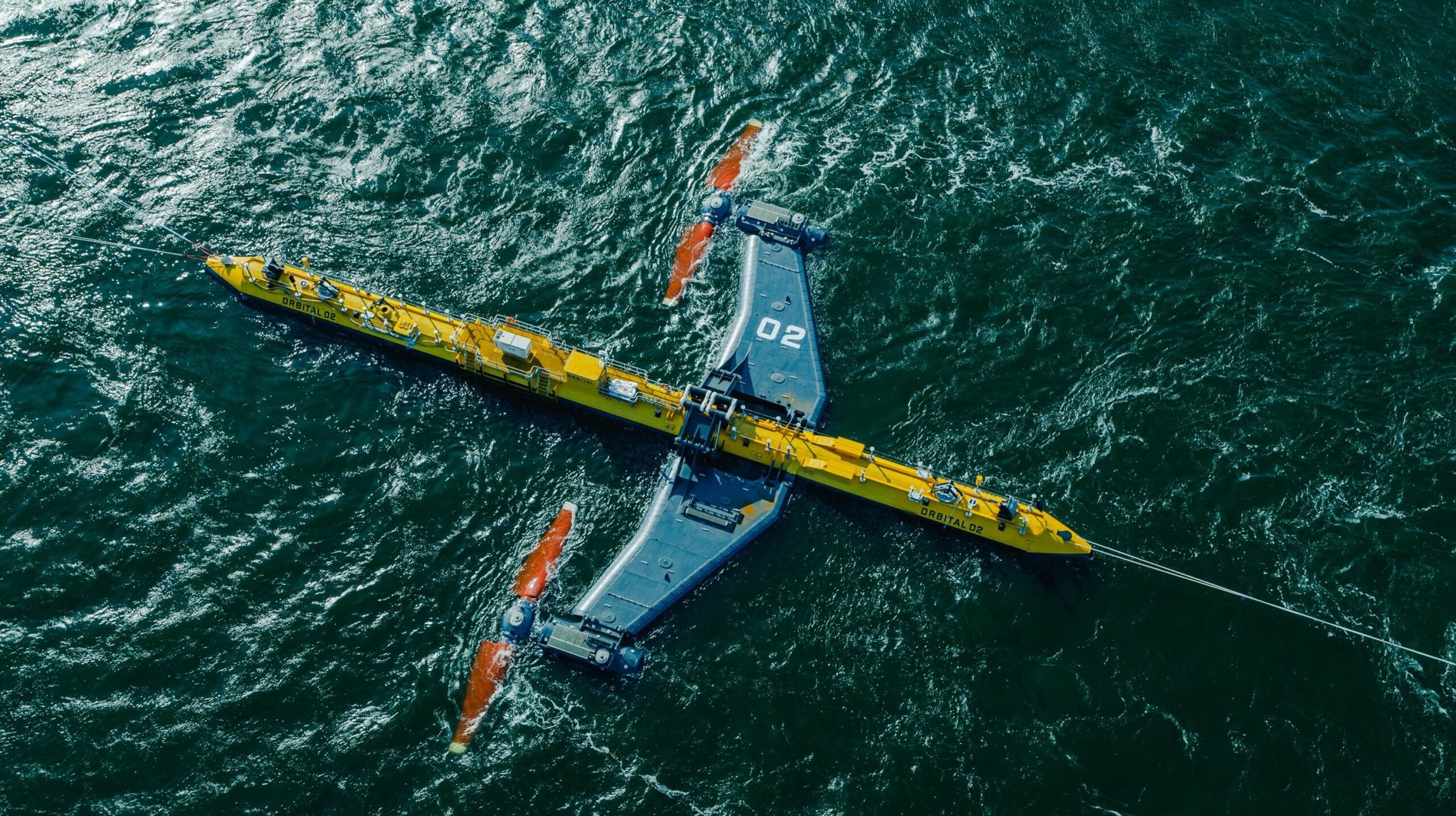
Hydro & Marine Power
Orbital 02 Tidal Turbine (Credit: Orbital Marine Power Ltd)
What is it?
Hydropower is made up of energy produced by four different energy sources: run-of-river, water storage, pumped water storage, and offshore hydropower (wave & tidal). Hydropower is based on the principle of harnessing the kinetic energy from moving water to turn turbines. The only exception to this is wave power, which harnesses the vertical movement of waves to move magnets within generator coils, producing electricity.
How does it work?
In its simplest form, hydropower is driven by the kinetic energy of water that is moving from one place to another. This kinetic energy is harnessed by directing water flow over a turbine which causes it to spin and once connected to a generator, produce electricity. The water flow is driven by gravity (excluding wave), so it has the potential to be an infinite source of energy if there is enough water available. As previously stated, wave power is slightly different to this in the way it generates electricity, but the fundamental principle of harnessing the kinetic energy of water remains the same.
How hydro power works (Credit: Student Energy)
How tidal power works (Credit: Student Energy)
How wave power works (Credit: OurFuture.Energy)
What are the advantages of hydro/marine power?
Predictability – Hydropower production is highly predictable and can be relied upon to generate a year-round supply of electricity. However, run-of-river hydro is dependent on water flow, so there are areas of the UK where this would not be a viable technology due to regional fluctuations in rainfall and tidal currents.
Scalability – It is relatively scalable, especially hydropower that is generated by run-of-river, which can be harnessed by small power plants if there is enough water and a steep drop in elevation.
Long lifecycle - Hydroelectric generators tend to have low maintenance costs in relation to the total energy that they produce. Large power plants have an expected lifespan of 100+ years, making them a realistic economic alternative. The exception to this is both marine and wave power production, which due to the degrading effects of salt water, have a greater need for maintenance.
What are the disadvantages of hydropower?
Start-up costs – The initial costs associated with building a large-scale hydroelectric power plant are very high, especially if it relies on artificially created water storage.
Fledgling technology (marine) – Both tidal and wave power have great potential, but they are relatively new technologies that require more research and investment before they can be scaled up and delivered at a national level.
Environment – If an artificial catchment area is built to enhance water storage via flooding, then the impact on local ecosystems both upstream and downstream can be catastrophic.
Current energy production?
In Q1 of 2022 hydropower accounted for 2.2% of the total electrical energy produced in the UK. This is below the global average where hydro accounts for 60% of renewable energy, and 15.9% of the total energy produced. This is likely a result of both our topography and our climate. In comparison to other nations, the UK does not have enough large water courses that can supply major hydroelectric power plants, and our climatic conditions favour other renewable alternatives which are cheaper to develop.
Where are the hydropower plants located?
The illustration below shows where hydropower is currently being produced in the UK. The general trend is for hydropower stations to be constructed in mountainous areas which experience higher rates of rainfall and water flow. The exception to this rule is the tidal power projects in the Orkney Islands and a wave power project off the coast of Cornwall. The size of the circles is dictated by electrical power generation, as you can see from the illustration, the Dinorwig Power Station in Wales produces significantly more electricity than any other hydropower project.
Hydro power production in the UK (Credit: Carbon Brief)
Key projects in the industry
Dinorwig Power station - https://www.fhc.co.uk/en/power-stations/dinorwig-power-station/
Orbital 2 Tidal Power Project - https://www.orbitalmarine.com/
Cruachan Power station - https://www.visitcruachan.co.uk/
Future projects and development of hydropower
The future of land-based hydropower is unclear. However, recent studies that looked into the UK’s hydro potential found that it could generate up to 2% of the total energy requirement. This is a modest amount in relation to other renewable technologies. The decision on harnessing this remaining potential will likely depend on the financial costs associated with building new power stations and how these compare with alternative technologies.
The future of marine-based hydropower looks significantly more promising, especially tidal power production. On 24 November 2021, the UK government announced an investment of £20 million to support the development of the tidal energy industry. This industry remains in a proof-of-concept stage, like deep geothermal power, so the jobs in the industry remain highly specialist. However, it has great potential, and service leavers need to follow the progress of this technology as it will likely play a key role in the UK’s future energy mix.
Orbital 02 Tidal Turbine (Credit: Orbital Marine Power Ltd)
Dinorwig Power Station (Credit: Fully Charged Show)

